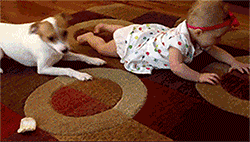
30 Jul Crawling: The Myths and Truths
3 min. readAs most parents believe, crawling is an important milestone for any growing baby; however, it isn’t crucial. And while many parents may see crawling as the marking of a new, and sometimes chaotic, chapter—there is no need to worry if your baby isn’t crawling like other babies.
Crawling can be an important milestone for your child, and it is quite common.
Crawling should take place on a child’s hands and knees. While different kids may try to scoot around or move themselves in different patterns while in this position—the proper way to crawl is in a cross-body pattern. This means the right arm and the left leg move forward at the same time, also known as cross-crawl.
It is important to differentiate this type of crawling from belly crawling or scooting—because the cross-crawl body pattern takes a great deal of coordination and signifies the development of specific motor skills.
So, why exactly is this cross-crawl pattern so important? Here are a few of the many reasons this action is so important:
- It helps children lift their head off the ground and develop the skills necessary to support their upper-body with their arms.
- This crawling pattern builds strength and stability in the legs.
- Crawling provides babies with the opportunity to explore their environment.
- As children crawl, their brains are able to make more connections and need to use a lot of areas of their brain just to move.
- Crawling can help babies develop spatial skills and the ability to locate objects using sight or touch.
- Crawling can help children develop cognitive skills.
- Babies will develop new senses of depth perception as they realize that objects don’t shrink or grow as they get farther or closer away.
- Crawling will help babies focus their gaze or attention.
Typically, children start to crawl between the ages of 7 months and 10 months of age. Most children will then become competent crawlers by the age of one.
Of course, crawling is also a predecessor to walking—a milestone that most parents look forward to. The average age of walking is about 12 months—so it is important to keep this in mind when recording your baby’s movement progress.
If your child doesn’t crawl, no need to worry. Not all babies learn to move through crawling. Once a baby learns to sit up and to get up on all fours, they simply go to pull up and get to a standing position which then leads to walking. Whether a baby chooses to transition to walking through crawling or sitting up doesn’t matter – the important thing to keep in mind is that they are progressing in their movement.
Crawling can be a big movement for a baby, but it doesn’t have to be the only way to transition them to one day walking. If you have any questions on your baby’s development or have questions about crawling, we are here to help. Here at Continuum Pediatrics, we can help you with all of these questions, or any other questions you may have about your baby’s major milestones. To schedule an appointment, just give us a call at 817-617-8600 today.

